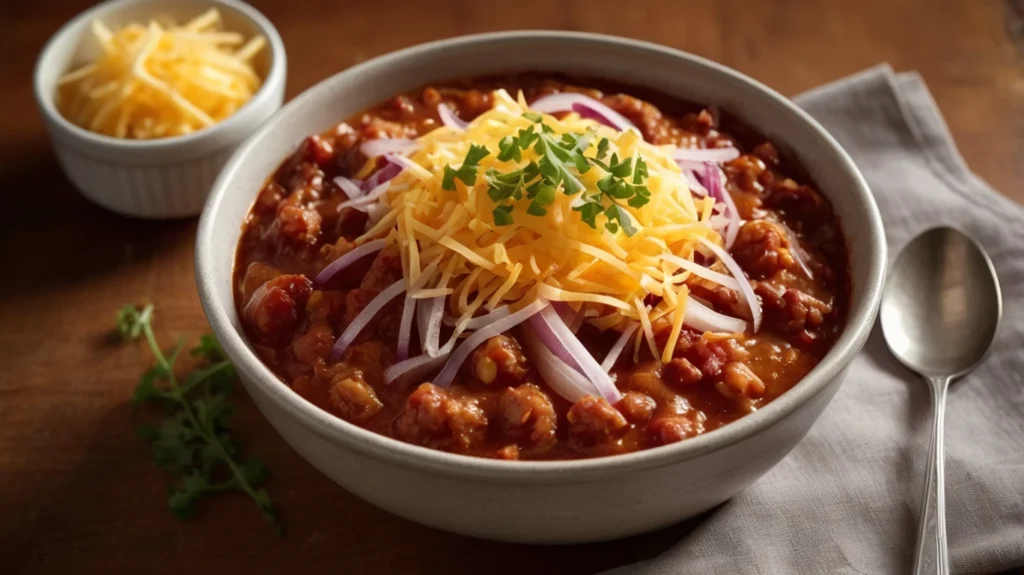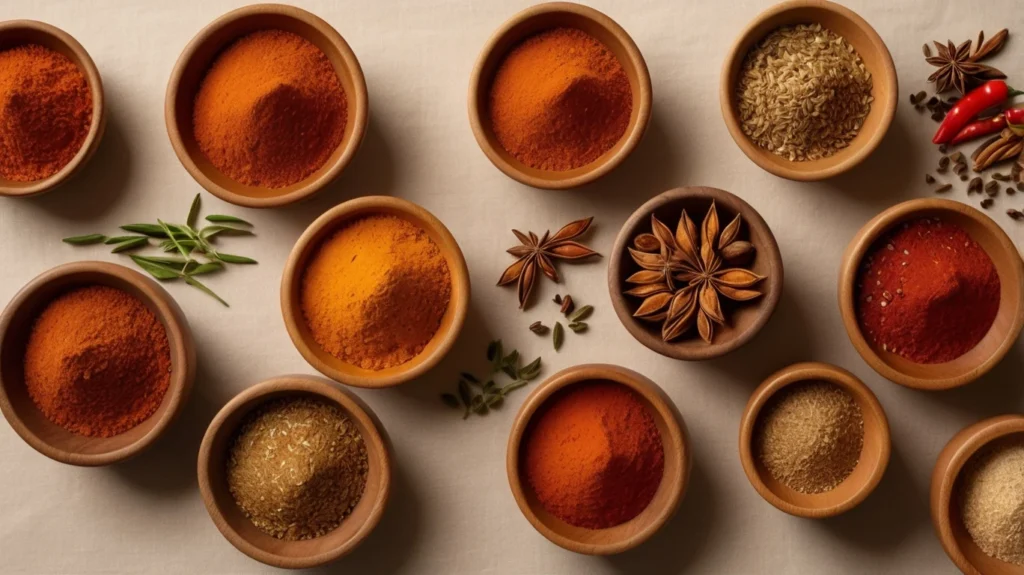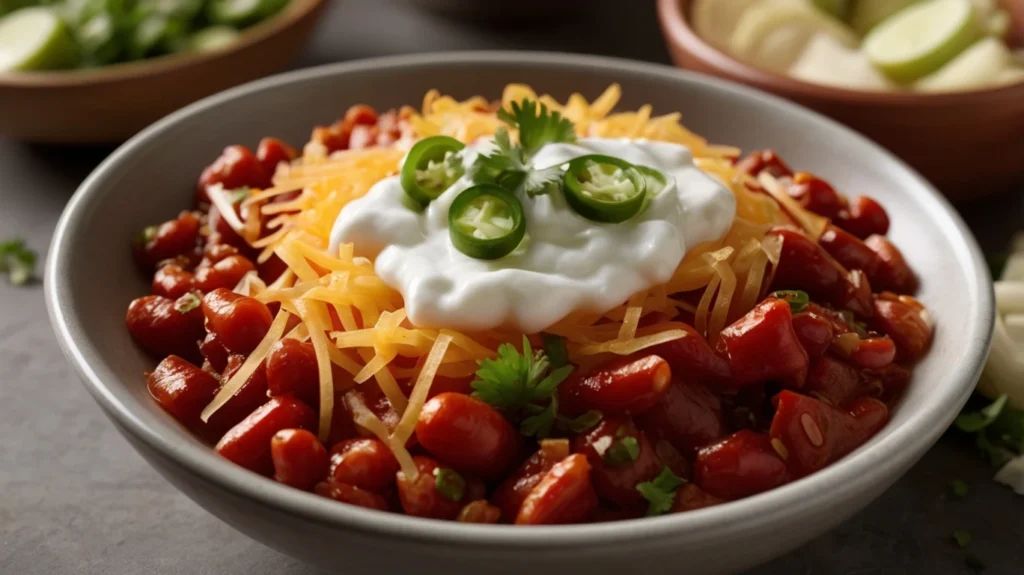What is the difference between chili and white chili? This is one of the most debated topics among chili lovers, and the answer lies in their ingredients, seasonings, and cooking styles.
In this guide, we’ll break down the key differences between chili and white chili, explore their histories, and figure out who prefers which type. So, grab a spoon and let’s dig in!
Understanding the Basics of Chili and White Chili

At first glance, chili and white chili seem like distant relatives—similar yet fundamentally different. The biggest difference is the color and base ingredients.
- Traditional chili (also known as “red chili” or “Texas chili”) is a tomato-based dish made with ground beef, kidney beans (depending on who you ask), and a variety of spices like cumin, chili powder, and paprika.
- White chili, on the other hand, is typically creamier and lighter in color. Instead of tomatoes, it uses a broth-based sauce, and instead of beef, it often features chicken or turkey. White beans, such as cannellini or Great Northern beans, replace kidney beans.
Both versions offer rich, hearty flavors, but their ingredients and seasonings create completely different taste experiences.
Why People Love These Two Chili Variations
Chili lovers are passionate, and both red chili and white chili have loyal followings. Here’s why people swear by each version:
Traditional Chili Lovers
- Enjoy bold, smoky, and spicy flavors.
- Love the deep tomato-based sauce.
- Prefer the hearty texture of ground beef.
- See it as the classic, unbeatable chili for cook-offs.
White Chili Fans
- Prefer a milder, creamier taste.
- Love the lighter chicken and white bean combination.
- Appreciate the comforting, soup-like consistency.
- Enjoy the versatility—can be spicy, mild, or extra creamy.
Ultimately, it comes down to personal taste—whether you’re in the mood for a smoky, tomato-rich bowl or a creamy, lighter option.
A Brief History of Traditional Chili
To understand the difference between chili and white chili, it helps to know where they came from. Traditional chili has deep roots in Mexican and Texan cuisine, while white chili is a more recent American innovation.
The Origins of Classic Chili
Chili as we know it today originated in Texas. The earliest versions were made by cowboys and settlers who needed a filling, protein-packed dish that could be easily prepared over a fire.
- The recipe evolved with influences from Mexican spices and European cooking techniques.
- Early chili contained dried beef, dried chili peppers, and suet (a type of fat) mixed into a thick, stew-like meal.
- By the 20th century, chili had become a staple of state fairs, cook-offs, and American diners.
Texas is so serious about its chili that the official state dish of Texas is chili—without beans!
Chili as we know it today originated in Texas. The earliest versions were made by cowboys and settlers who needed a filling, protein-packed dish that could be easily prepared over a fire. The recipe evolved with influences from Mexican spices and European cooking techniques. If you’re curious about the full history of chili ,Smithsonian Magazine has a fascinating deep dive into its origins.
How White Chili Gained Popularity

Unlike traditional chili, white chili doesn’t have centuries of history. It’s a relatively modern American invention that likely gained popularity in the 1980s and 1990s.
- Cooks experimented with lighter chili recipes using chicken instead of beef.
- White beans were introduced as a creamier alternative to red kidney beans.
- The dish became popular in health-conscious communities as a leaner chili option.
White chili is now a favorite in colder months, offering a comforting, creamy meal that’s different from the classic tomato-based version.
Who Prefers Which Type of Chili?
The great chili debate isn’t just about ingredients—it’s about who eats what and where. Regional and personal preferences play a huge role in the love for each type.
Regional Preferences in Chili Styles
Depending on where you live, your idea of “real chili” might be different.
- Texas: Traditional chili is king—no beans, no tomatoes, just meat and spices.
- Midwest & South: Red chili is popular, but white chili has gained traction, especially in colder areas.
- Southwest: Chili is a staple, often with a mix of Mexican and American flavors.
- West Coast & Northeast: More variety—restaurants and home cooks enjoy both versions equally.
The Role of Personal Taste in Choosing Chili
At the end of the day, chili is a personal experience. Some people prefer:
- Red chili for a classic, bold, spicy kick.
- White chili for a milder, creamier, more soup-like dish.
- Both—because why choose when you can enjoy both flavors?
Whether you’re team red chili or white chili, one thing is certain: there’s no wrong way to enjoy a bowl of chili!
ÉKey Differences & Ingredients
Now that we’ve covered the basics, it’s time to dive into the nitty-gritty of what sets traditional chili and white chili apart. While their visual differences are obvious—one is deep red, the other creamy white—the true distinction lies in their ingredients, seasonings, and cooking methods.
If you’ve ever wondered, “What exactly makes white chili… white?” or “Can I swap the meat and still call it chili?”—this section will answer all your burning questions.
Key Ingredients in Traditional Chili vs. White Chili
The biggest culinary divide between these two chili types is in their core ingredients. Traditional chili thrives on rich, bold flavors, while white chili leans toward a milder, comforting profile.
| Ingredient | Traditional Chili | White Chili |
| Meat | Ground beef, chuck, or brisket | Chicken or turkey |
| Beans | Kidney beans or pinto beans | White beans (cannellini, Great Northern) |
| Base | Tomato sauce, diced tomatoes | Chicken broth or cream |
| Spices | Chili powder, cumin, paprika | White pepper, cumin, green chilies |
| Thickness | Thick and stew-like | Creamier, often soupier |
Let’s break down these key differences further.
The Role of Meat: Beef vs. Chicken
Meat plays a huge role in the texture and flavor of chili.
- Traditional chili: Usually made with ground beef or even cubed chuck for a rich, hearty dish. Beef adds deep umami flavors, complementing the smoky tomato base.
- White chili: Uses chicken or turkey, which gives it a lighter and slightly sweet taste. Chicken soaks up the creamy broth, making the dish feel comforting and smooth.
If you’re a beef-lover, traditional chili will likely be your go-to. But if you enjoy leaner proteins, white chili offers a healthier, just-as-satisfying alternative.
The Importance of Beans in Chili Recipes
The bean debate is real. Some chili purists argue that “real chili” shouldn’t have beans at all (looking at you, Texas!), while others see beans as an essential component.
- Traditional chili: Uses kidney beans, pinto beans, or black beans, depending on the region. They add texture and extra protein, but they’re not required for Texas-style chili.
- White chili: Relies heavily on white beans, such as Great Northern, cannellini, or navy beans. These beans have a creamier texture and help thicken the dish.
What If You Can’t Use White Beans?
Whether you don’t have white beans on hand or need a low-carb option, there are substitutes.
Common Bean Substitutes for White Chili:
- Chickpeas (garbanzo beans) – Creamy, nutty, and similar in texture.
- Cauliflower florets – A low-carb option that absorbs flavors well.
- Lentils – Add thickness and an earthy taste.
Swapping beans won’t ruin white chili, but it will slightly alter its signature texture.
The Difference in Seasonings and Spices

A huge factor in what makes these chilis taste so different is the spice blend.
Traditional Chili Spices:
- Chili powder – The backbone of red chili flavor.
- Cumin – Adds warmth and a hint of earthiness.
- Paprika – Enhances the smoky depth.
- Garlic & onion powder – Essential for boosting savory notes.
White Chili Spices:
- White pepper – Milder than black pepper, adding gentle heat.
- Cumin – A shared ingredient, but used more subtly here.
- Oregano – Adds herbal brightness.
- Green chilies – Bring heat without overpowering.
White Chili Powder vs. White Pepper
White chili powder and white pepper sound similar, but they serve different purposes.
- White chili powder is a blend of mild ground chilies.
- White pepper is made from dried, ground white peppercorns and has a subtle heat.
If you don’t have white chili powder, you can use a mix of cumin, white pepper, and a pinch of cayenne to mimic its flavor.
How Different Spices Affect the Flavor
Spices define the entire personality of the dish:
- Traditional chili is bold, smoky, and rich due to chili powder and paprika.
- White chili is milder, tangier, and slightly herbal from cumin and oregano.
While both versions have depth and warmth, traditional chili leans toward robust heat, while white chili leans toward subtle spice and creaminess.
Cooking Methods: How Each Chili Is Made
Even the cooking process varies between these two dishes. Traditional chili is often slow-cooked, while white chili can be made quickly on the stovetop.
Slow Cooking vs. Quick Stovetop Preparation
| Cooking Method | Traditional Chili | White Chili |
| Slow Cooker | Ideal for developing deep flavors | Works, but broth may become too thick |
| Stovetop | Standard method, takes 1–2 hours | Quickest method, takes 30–40 minutes |
| Pressure Cooker (Instant Pot) | Cuts cooking time in half | Perfect for tender chicken |
Traditional chili needs longer cooking times to break down beef and develop rich flavors. White chili, however, comes together faster because chicken cooks more quickly than beef.
Best Techniques for Making Each Chili
For Traditional Chili:
- Brown the beef first for extra flavor.
- Let it simmer for at least an hour for deeper spice infusion.
- Stir occasionally to prevent burning at the bottom.
For White Chili:
- Use rotisserie chicken for an even quicker meal.
- Simmer with white beans to thicken naturally.
- Add a splash of cream or sour cream for extra richness.
The method you choose depends on how much time you have. For a slow-cooked, hearty dish, go red chili. For a fast, creamy meal, go white chili!
Nutritional & Flavor Profiles
By now, we’ve established the major ingredient and cooking differences between traditional chili and white chili. But how do they compare when it comes to nutrition and flavor?
Some chili lovers swear that red chili is more filling, while others prefer the lighter, comforting feel of white chili. If you’ve ever wondered which one is healthier or what to serve with each type, let’s break it down!
Comparing the Nutritional Benefits of Both
While both chilis are hearty and satisfying, their nutritional profiles differ based on ingredients.
Which Chili Is Healthier?
| Nutritional Factor | Traditional Chili (Per Serving) | White Chili (Per Serving) |
| Calories | ~350-450 kcal | ~250-350 kcal |
| Protein | High (~25g from beef) | Moderate (~20g from chicken) |
| Carbs | Higher (due to beans & tomatoes) | Lower (fewer carbs in broth-based chili) |
| Fat Content | Higher (from ground beef) | Lower (lean chicken or turkey) |
| Sodium | Moderate to high (depends on canned ingredients) | Can be lower with homemade broth |
| Fiber | High (kidney beans, tomatoes) | Moderate (white beans) |
Breaking It Down
- Traditional chili tends to be higher in calories and fat due to the beef and tomato-based sauce.
- White chili is usually lighter, since it often contains chicken and a broth base rather than a thick tomato sauce.
If you’re looking for a lower-calorie, leaner option, white chili is the way to go. But if you want more protein and hearty flavor, traditional chili might be your best bet.
Adjusting Recipes for Dietary Needs
Both versions of chili can be customized to fit different diets. Here’s how:
Low-Carb or Keto-Friendly Chili
- Traditional chili: Skip the beans and use more ground beef and veggies.
- White chili: Reduce or omit white beans, using cauliflower or shredded chicken for texture.
Gluten-Free Chili
Both chilis are naturally gluten-free as long as no flour or thickening agents are used. Just double-check store-bought broth and seasoning packets.
Dairy-Free White Chili
Many white chili recipes use cream or cheese, but you can swap:
- Coconut milk or cashew cream for dairy-free creaminess.
- Nutritional yeast for a cheesy flavor without dairy.
White chili is more likely to have dairy-based ingredients, but it can be made completely dairy-free with a few adjustments!
What to Serve with Chili vs. White Chili
Pairing the right side dishes and garnishes can take your chili to the next level.
The Best Side Dishes for Classic Chili
Traditional chili has a bold, smoky flavor that pairs well with:
- Cornbread – A classic Southern pairing, slightly sweet to balance the spice.
- Rice – A great option for making chili stretch into more servings.
- Tortilla Chips – Crunchy and perfect for dipping.
- Baked Potatoes – Load them up with chili for a filling meal.
Perfect Pairings for White Chili
White chili has a creamier texture, so it pairs well with:
- Garlic Bread – Soaks up the flavorful broth.
- Soft Flour Tortillas – Great for scooping up the chili.
- Side Salad – A fresh contrast to the warm, creamy chili.
- Avocado Slices – Adds richness without overpowering the dish.
Garnishes That Enhance Each Chili
| Garnish | Traditional Chili | White Chili |
| Shredded Cheese | Cheddar, Monterey Jack | Pepper Jack, Mozzarella |
| Sour Cream | Balances spice | Adds creaminess |
| Chopped Onions | Red onions for bite | Green onions for mild flavor |
| Jalapeños | Spicy kick | Milder heat |
| Cilantro | Fresh contrast | Complements creamy broth |
Both types of chili taste even better with toppings that add texture and contrast.
Why Both Versions Are Worth Trying
Chili is one of those dishes that everyone makes differently, and that’s what makes it fun! Whether you love the smoky kick of classic chili or the comforting, creamy taste of white chili, there’s no wrong choice.
How to Choose the Right Chili for the Occasion
- For a game day party? Traditional chili wins.
- For a cozy winter night? White chili is perfect.
- Want to impress guests? Make both and let them choose!
Making Both for a Tasting Event
If you can’t decide, why not make both and serve them side by side? Set up a chili bar with different toppings and let everyone customize their bowl.
No matter which chili you prefer, the best part is that both are packed with flavor, warmth, and comfort—and that’s what makes them timeless favorites!
FAQs About What Is the Difference Between Chili and White Chili?
Still have questions? No worries! Here are the answers to some of the most common questions about traditional chili and white chili.
What is the meaning of white chili?
White chili is a creamy, broth-based version of chili that uses chicken instead of beef and white beans instead of kidney beans. Unlike traditional chili, it doesn’t have a tomato base, which gives it its signature light color and milder flavor.
Where does white chili originate?
White chili doesn’t have the deep historical roots of traditional chili, but it likely originated in the United States as a creative spin on classic chili. It gained popularity in the 1980s and 1990s, especially among home cooks looking for a lighter, creamier alternative to red chili.
What is a substitute for white beans in chili?
If you don’t have white beans, you can substitute:
- Chickpeas (garbanzo beans) – Similar texture with a slightly nutty taste.
- Cauliflower florets – A great low-carb alternative.
- Lentils – Add thickness and protein without changing the flavor too much.
These swaps keep the creamy consistency of white chili while giving it a unique twist.
Is white chili powder the same as white pepper?
No, they are not the same!
- White chili powder is a mild spice blend made from dried white or yellow chilies.
- White pepper is ground from white peppercorns, offering a milder, earthy heat.
If a recipe calls for white chili powder and you don’t have it, try mixing cumin, white pepper, and a pinch of cayenne for a similar effect.
How do I adjust spice levels in both chilis?
To make either chili spicier:
- Add jalapeños, cayenne pepper, or crushed red pepper flakes.
- Use spicy green chilies in white chili.
- Increase the amount of chili powder or smoked paprika in traditional chili.
To make chili milder:
- Add a little sugar or honey to balance the heat.
- Stir in sour cream or cheese to cool down the spice.
- Use mild peppers instead of hot ones.
Can I make chili or white chili vegetarian?
Yes! Here’s how:
- Traditional chili: Swap the meat for mushrooms, lentils, or plant-based crumbles.
- White chili: Use cauliflower, jackfruit, or extra beans instead of chicken.
For extra flavor, roast the vegetables before adding them to the chili.
What toppings work best for each type?

| Topping | Traditional Chili | White Chili |
| Cheese | Cheddar, Monterey Jack | Pepper Jack, Mozzarella |
| Sour Cream | Balances heat | Adds extra creaminess |
| Onions | Red onions for bite | Green onions for freshness |
| Avocado | Not common, but works | Pairs perfectly |
| Jalapeños | Classic spicy kick | Great for mild heat |
Adding toppings lets you customize your chili for extra texture and flavor.

